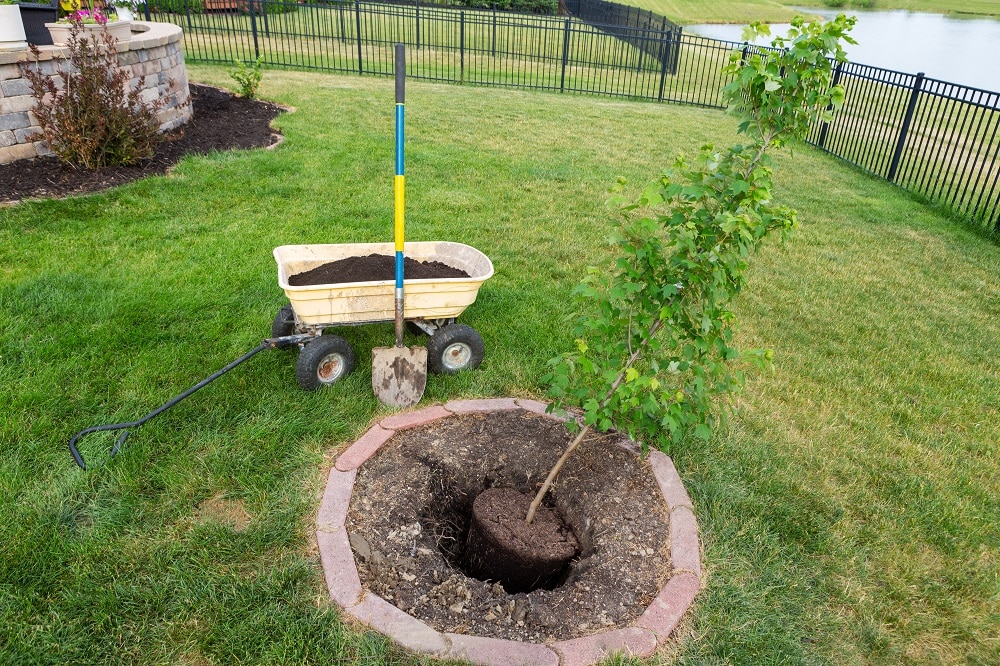Written by Jennifer Noonan, Bob Vila and published on https://www.bobvila.com/
You’ve invested time and money in your landscape but landscapes evolve and mature over the years. At some point, you may need to make changes. These changes could include moving established trees.
Transplanting a small tree (sapling) is a little more involved than simply buying a container-grown tree and setting it out—a few extra considerations come into play. Nevertheless, the basic principles of preparation and care are the same. With a bit of effort and determination, your young tree will be healthy and growing in no time.
HOW TO TRANSPLANT A TREE: WHAT TO DO AND WHAT NOT TO DO
Trees root into the earth, but that doesn’t mean they are impossible to remove from the ground and transport to a new home.
You love your trees, but sometimes they’re better suited for locations elsewhere. Perhaps they’ve outgrown the space in which they’re rooted, or, maybe you plan to move somewhere new but wish to bring that special tree along with you.
GUIDELINES FOR SAFE & PROPER TRANSPLANTING OF TREES
Regardless of the tree you’re moving and space to which you plant transport it, there are several guidelines to follow for the safe and proper transplanting of trees:
WHEN IS THE BEST TIME OF YEAR TO TRANSPLANT A TREE?
There are good and not-so-ideal times of the year to transplant trees. “The best time to transplant a tree is when it’s dormant and the ground conditions are ‘just right,’” says Rick Hanshaw, manager of the Davey Nursery in Wooster, Ohio. Find the best months of year to transplant your tree, including your pine, oak, maple or fruit tree.
WHAT SHOULD I CONSIDER WHEN PICKING A NEW HOME FOR A TREE?
Ideal transplanting locations depend on the size and species of the tree you transplant. According to Hanshaw, trees prefer different levels of shade and sun, as well as varying soil drainage conditions. The potential height and size of the tree and the location of home foundations, power lines and underground utilities all affect the transplanting location. “You need to identify the tree species first,” Hanshaw says. “There are a lot of different variables involved with choosing the correct location to which to transplant a tree.”
TRANSPLANTING MATURE TREES VS. YOUNG TREES
There isn’t a big difference between transplanting mature trees vs. young trees. The vigorous growth rate and easily manageable root ball of a young tree make its transplanting process fairly easy. However, all trees experience some degree of shock after being transplanted—the length of recovery time simply depends on the quality of aftercare. “Mature trees will just take more aftercare than younger trees after being transplanted,” Hanshaw says.
CAN ALL TREES BE TRANSPLANTED?
Some tree species react better to transplanting than others. According to Hanshaw, red maples, elms, and bald cypress generally respond better to being transplanted than other species, in northern regions, in particular. “Specifically red maples have much more fibrous root systems of which you can capture more when digging,” Hanshaw explains.
Most trees will move well, assuming proper time is allotted to correctly fertilize, root prune, dig the properly sized root ball and water before and after transplanting. It is equally important to continue a pest management/fertilization program after transplanting, as the tree can have a 1- to 2-year root transition growth before becoming reestablished.
The only conditions for which we do not recommend relocating a tree include:
- The tree is in a state of stress/deterioration that would warrant a removal
- The new location is unsuitable for the specified tree.
SET YOURSELF UP FOR SUCCESSFUL REPLANTING
- Ensure the time and budget required to transplant a tree in a careful, timely manner is available.
- Your tree will lose a significant amount of its root system during transplanting. Make sure it’s well-hydrated before the transplanting process begins.
- Once the tree is uprooted, tie up the crown as much as possible to reduce limb breakage during the move.
- Wrap the tree in a tarp to reduce wind damage and moisture loss.
- Water the tree as soon as possible after transplanting. This is the most important.
- Follow up with proper tree care and inspections for insect damage.
Original post here https://www.bobvila.com/articles/how-to-transplant-a-tree/.


